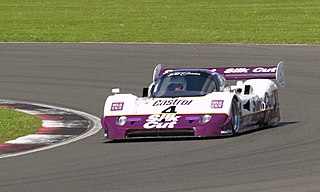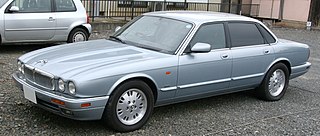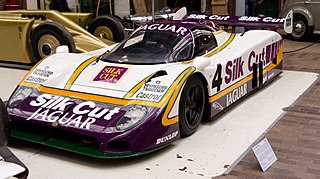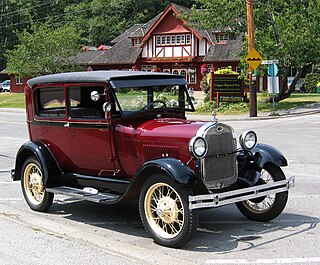
The Jaguar V12 engine is a V12 engine produced by Jaguar Cars. Based loosely on an earlier design for an intended Le Mans car, the Jaguar XJ13, it was first seen in the Series 3 Jaguar E-type of 1971. The V12 was only Jaguar's second engine design to go into production in the history of the company. The all-alloy block was fitted with removable wet liners and had a SOHC two-valve alloy head with flat block mating surface, and the combustion chamber in the piston crown carved in a shallow cup form. It was regarded by some as one of the premier powerplants of the 1970s and 1980s.

The AJ6, and the similar AJ16, were inline-6 piston engines used by Jaguar cars in the 1980s and 1990s. The AJ6 was designed to replace the successful and long-used Jaguar XK6 engine, and was introduced in 1984. It was only the third all-new engine ever designed by the company. The AJ16 evolution was replaced in 1996 with the Jaguar developed AJ-V8 engine.

The Jaguar XJ220 is a two-seat sports car produced by British luxury car manufacturer Jaguar from 1992 until 1994, in collaboration with the specialist automotive and race engineering company Tom Walkinshaw Racing. The XJ220 recorded a top speed of 212.3 mph (341.7 km/h) during testing by Jaguar at the Nardo test track in Italy. This made it the fastest production car from 1992 to 1993. According to Jaguar, an XJ220 prototype managed a Nürburgring lap time of 7:46:36 in 1991 which was faster than any production car lap time before it.

The Jaguar Sport XJR-15 is a two-seater sports car produced by Jaguar Sport, a subsidiary of Jaguar and Tom Walkinshaw Racing between 1990 and 1992. Only 53 were made, each selling for GB£500,000. The chassis was mechanically based on the Le Mans-winning XJR-9, designed by Tony Southgate. The body of the XJR-15 was designed by Peter Stevens, who went on to co-design the McLaren F1. The car competed in a single-make racing series called the Jaguar Intercontinental Challenge, which supported three Formula 1 races in 1991. The XJR-15 was the world's first road-car made entirely from carbon-fibre.
Tom Walkinshaw Racing (TWR) was a motor racing team and engineering firm founded in 1976, in Kidlington, near Oxford, England by touring car racer Tom Walkinshaw.

The Jaguar XJR-9 is a sports-prototype race car built by Jaguar for both FIA Group C and IMSA Camel GTP racing, debuting at the 1988 24 Hours of Daytona.
The 1991 24 Hours of Le Mans was the 59th Grand Prix of Endurance, and took place on 22 and 23 June 1991. It was also the fourth round of the 1991 FIA Sportscar World Championship season.
The 1990 24 Hours of Le Mans was the 58th Grand Prix of Endurance, and took place on 16 and 17 June 1990.

The Nissan R390 GT1 was a racing car built in Atsugi, Japan. It was designed primarily to gain a suitable racing entry in the 24 Hours of Le Mans in 1997 and 1998. It was built to race under the grand touring style rules, requiring a homologated road version to be built. Therefore, the R390 was built originally as road car, then a racing version of the car was developed afterwards. Only one R390 road car was ever built and is stored at Nissan's Zama facility. The road car was claimed to be capable of attaining a top speed of 354 km/h (220 mph). However, this claim has never been proven.

The Jaguar XJR-14 is a sports-prototype racing car introduced for the 1991 World Sportscar Championship season. It was designed by Ross Brawn and John Piper, and was built and run by Tom Walkinshaw Racing (TWR), on behalf of Jaguar Cars.

The Jaguar XJR sportscars were a series of race cars used by Jaguar-backed teams in both the World Sportscar Championship (WSC) Group C and the IMSA Camel GTP series between 1984 and 1993.

The Jaguar XJR-11 was a sports-prototype racing car introduced for the 1989 World Sports Prototype Championship, while its sister car the XJR-10 was introduced to compete in IMSA series races.

The Jaguar XJR-12 is a sports-prototype race car built by the Jaguar Cars-backed Tom Walkinshaw Racing team for both Group C and IMSA Camel GTP. The XJR-12 is famous for winning the 1990 24 Hours of Le Mans race.

The Jaguar XJ (X351) is fourth generation of the Jaguar XJ executive saloon from Jaguar. Announced in 2009, and on sale from 2010, the fourth generation features combines revised styling with underpinnings of the previous X350 generation. The vehicle is produced at the Castle Bromwich Assembly plant in Birmingham, United Kingdom. In 2014, assembly from complete knockdown kits (CKD) of the XJ would commence in Jaguar Land Rover's facility in Pune, India.
Tony Southgate is a British engineer and former racing car designer. He designed many successful cars, including Jaguar's Le Mans-winning XJR-9, and cars for almost every type of circuit racing. He was responsible for the chassis design of Ford's RS200 Group B rally car. Southgate was employed as chief designer or technical director for many Formula One teams for over twenty years. These teams included BRM, Shadow and Arrows. Southgate retired after producing the Audi R8C, which was a major influence in the Bentley Speed 8, which won Le Mans in 2003. He continues to be a regular visitor to current and historic race meetings.

The Jaguar XJ (X300) is a full-size luxury sedan manufactured by Jaguar Cars between 1994 and 1997. It was the first XJ produced entirely under Ford ownership, and can be considered an evolution of the outgoing XJ40 generation. Like all previous XJ generations, it features the Jaguar independent rear suspension arrangement. The design of the X300 placed emphasis on improved build quality, improved reliability, and a return to traditional Jaguar styling elements.

The Jaguar XJ (X308) is a full-size luxury sedan manufactured and marketed by Jaguar Cars for years 1997-2003 across two generations and featuring Jaguar's AJ-V8 and Jaguar's independent rear suspension. It was the third and final evolution of the XJ40 platform which had been in production since 1986.

The XJR-8 was a race car built by Jaguar for campaigning in the World Sportscar Championship and at Le Mans as part of Group C. It was used during the 1987 season.
The Jaguar XJR-17 was an IMSA Lights racing car, built by Tom Walkinshaw Racing. Rebuilt from a Jaguar XJR-16 for the IMSA Camel Lights, the XJR-17 never competed in the event due to funding issues and has since only been used in a few minor British events and historic races. It used a modified version of the XJR-16's 3.5-litre V6 engine, stripped of the twin-turbochargers and producing a claimed output of 450 hp, whilst its bodywork was cobbled together using various parts from older Jaguar XJR Sportscars.

Jaguar R and SVR models are a range of high performance versions of certain car models of the British automotive companies Jaguar and Land Rover. These cars primarily focus on enhanced "sport" performance. Jaguar began producing R models in 1995 with the introduction of the first XJR, and began producing R-S models with the introduction of the 2012 XKR-S. The R-S marque has since been replaced by the SVR marque, which was first introduced on the 2017 Jaguar F-Type SVR. On 11 August 2014, the Range Rover Sport SVR was announced by Land Rover at Pebble Beach. The model sports a number of aesthetic alterations and performance improvements. This vehicle was introduced for the 2015 model year.

















